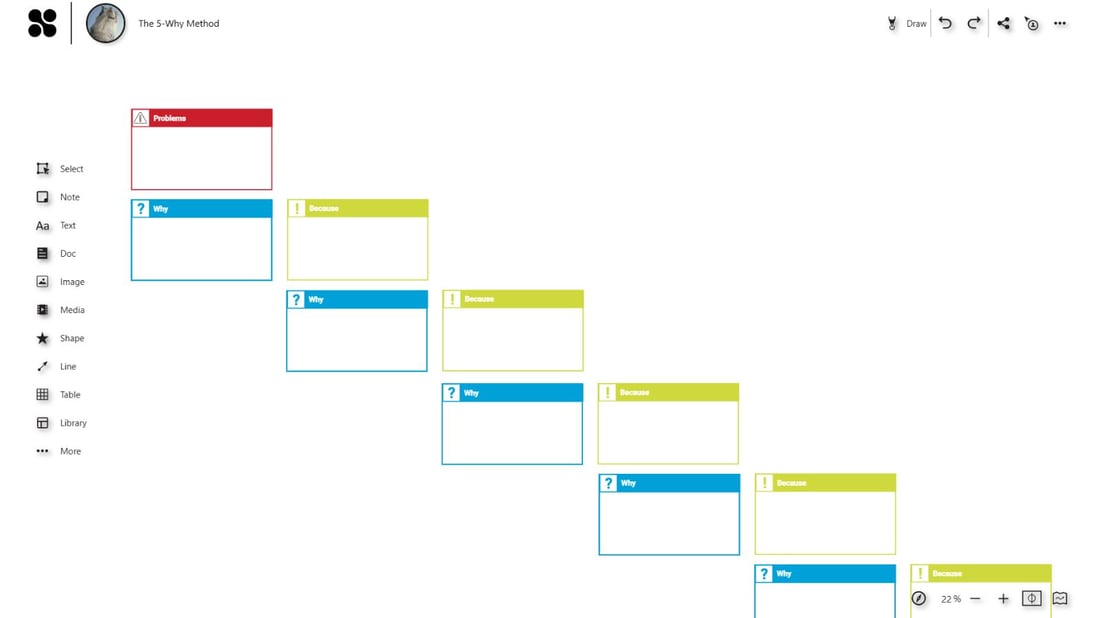In companies and in everyday life, we often face problems that at first glance appear to be solvable using simple methods. However, these quick solutions are often only of a short-term nature because they do not solve the actual cause of a problem. For this reason, the Japanese inventor Toyoda Sakichi developed the so-called 5 Why method. This method is primarily used in quality management. We explain what you need to look out for with the 5 Why method.
How the 5-Why method works
The 5-Why method shows the connection between cause and effect. Specific why questions can be used to find out the underlying cause of a problem. According to Toyoda, it is less about the number of questions and more about asking the right questions. So whether you get to the root cause with two, five or ten questions is irrelevant.
Whether you have actually arrived at the root cause can easily be determined by reversing the process. So if the currently named cause is the only possible one for the problem at hand and this cannot be broken down any further, you have arrived at the actual cause.
What is the 5-Why method used for?
There are many areas in which the 5-Why method is useful. Especially when you are faced with unexpected problems in the company, this method is a good way to find the underlying cause. The 5 Why method is also well suited to creativity techniques and sessions in order to present clear cause-and-effect relationships.
The 5-Why method: An example
In practice, the 5-Why method can look like this, for example:
Let's assume the initial problem is that your employee cannot use his microphone in the video conference. The following questions will now take us to the root cause:
-
Why can the employee not use his microphone?
-
Why can the employee not use his microphone?
-
-
Why was the employee unable to select or activate the microphone?
-
Because the laptop does not recognize the microphone.
-
-
Why does the device not recognize the microphone?
-
Because no up-to-date drivers are installed.
-
-
Why are no up-to-date drivers installed?
-
Because it is not clear whether the employee is allowed to install new software or drivers on the company laptop.
-
-
Why are these things still not clear?
-
The provision of the software is centralized and the contact information of the responsible department is not communicated conclusively.
-
You can now reverse this cause-and-effect: If the deployment is centralized and it has not been communicated who employees can contact for new drivers or software, the hardware will stop working because the appropriate drivers are not updated.
The next step is to find a solution. The first step is to install new drivers. This is important, but only fulfills an intermediate step, namely the why question number 3.
In order to eliminate the actual cause of the problem, the necessary contact information must be communicated to all employees. It must also be made clear whether employees are allowed to update the software on their company devices independently and, if not, who is responsible for this.
Use the 5-Why template in Collaboard for free.
The 5 W-questions: how to use them correctly
Toyoda Sakichi developed the Why questions for technical production. This means that they are primarily designed to depict simple, linear processes and to conduct a root cause analysis within these processes. In order to arrive at a clear answer to the question "why" as quickly as possible, it is important, according to the inventor, to involve everyone involved in the discovery process.
In the example company, this would be all employees who have access to the employees' company computers, the line manager and a person who is responsible for ordering hardware and software.
To rule out other faults with the appliance, it is also advisable to carry out an on-site inspection. According to Toyoda, technical causes can only be identified on site and not from a desk. However, a site visit is not useful for every problem. When it comes to digital problems, for example, it also makes sense to meet in the meeting room and present the problem using a projection from a computer.
The last application tip is to write down the questions. Visualization makes the question clearer for everyone involved, especially in remote teams where employees do not meet in person. Here it is all the more important to clearly visualize which questions and problems are involved. This approach also helps to ask the right questions and not get bogged down in trivialities. This also includes staying on a factual level and not assigning personal blame.
In our example, the second W question could have been "Why is the microphone not activated?" The answer could have been: "Because the employee didn't select the right device." The course of events would then have been completely different and would have assigned blame to one person for the microphone not working in the meeting. However, assigning blame is not the aim of the methodology, but rather finding solutions.
Once a solution has been found, it is important that you check the results regularly. This is the only way to ensure that the problem does not occur again. If this is not the case, you can apply the method again and then find out why hardware is not working despite the new planning of responsibilities.
Example of how the 5-Why method can be used with the template in the Online Whiteboard Collaboard:

Advantages of the 5-Why method
A major advantage of the 5- Why method is that it brings the employees of a company together and sharpens everyone's focus on the essentials. In creative processes, the method helps to develop precise questions and understand the cause-and-effect principle.
The method also helps you to critically scrutinize possible causes of problems and seemingly simple solutions. In the long term, this leads to productive work and better results for the entire team.
Disadvantages of the 5-Why method
The biggest disadvantage of the 5-Why method is that it only follows one path. For more complex problems with several possible solutions, this quickly leads to you only following one solution path and ignoring the other causes.
You can address this by trying out the various possible paths in several sessions and trying to find a connection between the causes. This can often lead to new solutions.
One way to counter this problem is the Ishikawa diagram, also known as a fishbone diagram. It consists of a skeleton, which resembles a fish bone, and various branches that represent the possible causes of the problem. Each branch is further divided into subgroups to break down the causes into smaller parts. The Ishikawa diagram is a valuable tool for identifying and solving the root causes of problems by encouraging communication between team members and supporting problem solving.
This visualisation of the problem, cause and solution enables you to present the 5-why-questions in equal measure and to find the main and secondary causes that are responsible for a problem.
5-Why method - Conclusion
The 5-Why method is used to find the fundamental causes of problems with the help of relatively simple questions. In quality management, creative processes and team building, the question "why" is essential and leads teams to ask critical questions and not to implement the supposedly simple solution. For more complex methods, it helps to visualise the answers to the five questions and thus illustrate the possible main and secondary causes.
Frequently asked questions & answers
What is the 5-Why method?
The 5-Why method is a root cause identification strategy that is used in quality management and other areas. It aims to find the "root cause", in other words the root of the problem.
What is the 5-Why method used for?
The 5-Why method is used to track down the cause of a problem with targeted "Why?" questions. The next step is to develop a solution that eliminates the cause of the problem.
What should I keep in mind with the 5-Why method?
The 5-Why method only works if the questions are asked very precisely. Think carefully about the possible questions and formulate the answers as precisely as possible.



